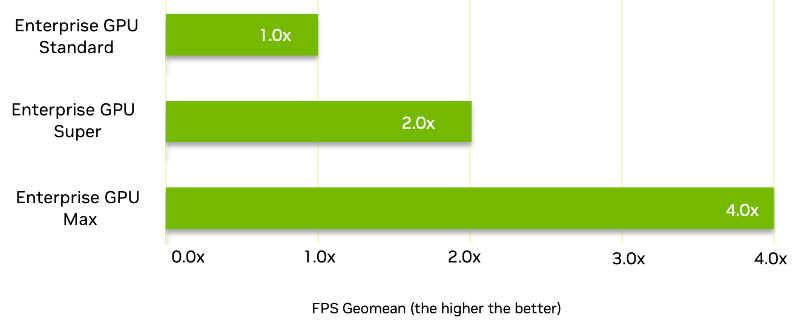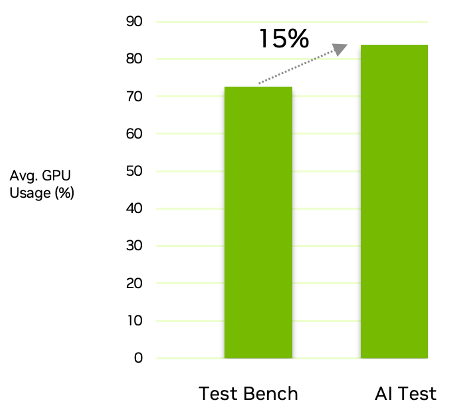We are entering a new era of AI-powered digital workflow, where Windows 365 Cloud PCs are dynamic platforms that host AI technologies and reshape traditional processes. GPU acceleration unlocks the potential for AI-augmented workloads running on Windows 365 Cloud PCs, enabling advanced computing capabilities for everyone.
The integration of NVIDIA GPUs with NVIDIA RTX Virtual Workstation into Microsoft Windows 365 GPU-enabled Cloud PCs marks a key development in cloud computing that boosts workflow efficiencies and enables you to perform complex, graphics-intensive tasks without the need for separate infrastructure.
The Windows 365 GPU-enabled Cloud PCs are available in three offerings, all of which can include NVIDIA Tensor Core GPUs:
- Windows 365 GPU Standard
- Windows 365 GPU Super
- Windows 365 GPU Max
This post explores the enhanced performance of Windows 365 GPU-enabled Cloud PCs While Microsoft doesn’t specify or guarantee any specific hardware, ours came provisioned with NVIDIA A10 GPUs. We tested them using three compute-intensive workloads to assess how GPU-enabled Cloud PCs with this configuration excel in specialized applications.
Accelerating AI-assisted content creation
AI enhances content creation and opens up new possibilities for innovative and captivating visual experiences. Blackmagic Design’s DaVinci Resolve offers many AI-augmented features, such as UltraNR, Super Scale, and Speed Warp, that streamline the film editing process. These AI features are accelerated by NVIDIA GPUs.
To evaluate the acceleration provided by the Windows 365 GPU-enabled Cloud PCs, we tested DaVinci Resolve’s general features (test bench) and AI-augmented features (AI test), measuring frame rate and GPU usage.
Figure 1 shows that Windows 365 Enterprise GPU Max, equipped with a fully dedicated GPU, delivers a 4x performance boost when powering AI features.

One user per VM. DaVinci Resolve 19 Beta tested on the following Windows 365 Cloud PCs configurations: Enterprise GPU Standard (12 vCPU, 110-GB RAM, 8-GB vRAM with A10, 512 GB), Enterprise GPU Super (18 vCPU, 220-GB RAM, 12-GB vRAM with A10, 1 TB), Enterprise GPU Max (36 vCPU, 440-GB RAM, 24-GB vRAM with A10, 1 TB), geomean. Sep. 2024
The dedicated GPU resource accelerates the processing of complex visual data, making it essential for many AI-driven advancements.
Figure 2 is a comparison of GPU usage between general features (test bench) and AI features (AI test) on the Windows 365 GPU Max offering. The 15% increase of GPU usage to power AI features indicates a performance dependency on GPU acceleration when end users want to take advantage of these cutting-edge capabilities.

on Windows 365 Enterprise GPU Max
One user per VM. DaVinci Resolve 19 Beta tested on the Windows 365 Enterprise GPU Max configuration (36 vCPU, 440-GB RAM, 24-GB vRAM with A10, 1 TB), avg GPU usage. Sep. 2024
While AI-augmented design tools push creative possibilities beyond traditional boundaries, choosing a more powerful GPU for your cloud PC is crucial to maximize AI capabilities and reduce costly rendering time.
Jumpstarting AI development
The journey of AI development typically begins with a proof of concept (PoC) where initial ideas are tested on a smaller scale to validate their feasibility and effectiveness. This preliminary phase enables you to experiment with algorithms, assess data requirements, and refine models in a controlled environment, ultimately providing valuable insights into the potential success of the project.
Windows 365 GPU Max offers you easy access to testing grounds for generative AI, particularly with small language models, enabling rapid development cycles without the need for new infrastructure. We used a Windows 365 Enterprise GPU Max Cloud PC to deploy Phi-3-mini-4K, a 3.8B small language model, for chatbot creation.
Figure 3 shows a 4.5x speed increase with a GPU-enabled Cloud PC compared to a CPU-only Cloud PC.

One user per VM, Phi-3-mini-4k-instruct-gguf tested on the Windows 365 Enterprise GPU Max configuration (36 vCPU, 440-GB RAM, 24-GB vRAM with A10, 1 TB), tokens per second. Sep. 2024
These results highlight how GPUs boost the efficiency of powerful Cloud PCs and shorten development time, a vital factor for developers operating in a dynamic AI landscape.
Boosting deep learning-enabled object detection in geospatial analysis
AI can significantly enhance geospatial analysis by automating the processing and interpretation of large datasets, enabling more efficient and accurate insights.
Here, we analyzed the effectiveness of GPU-enabled Cloud PCs in handling extensive datasets and performing intricate spatial calculations using ArcGIS Pro, a professional desktop geographic information system (GIS) application for exploring, visualizing, and analyzing data. We used three GPU-enabled Cloud PCs to process a pretrained deep learning model for detecting trees on a designated satellite map.
Figure 4 shows that Windows 365 GPU-enabled Cloud PCs can substantially enhance the efficiency of machine learning models, reducing processing time by up to 2x with the Windows 365 Enterprise GPU Max offering. During this evaluation, we also observed an average rendering time reduction of 12x compared to the CPU-only Cloud PCs.

One user per VM. Application: ArcGIS Pro, Deep Learning tool – tree detection models running on the following Windows 365 Cloud PCs configurations: Enterprise GPU Standard (12 vCPU, 110-GB RAM, 8-GB vRAM with A10, 512 GB), Enterprise GPU Super (18 vCPU, 220-GB RAM, 12-GB vRAM with A10, 1 TB), Enterprise GPU Max (36 vCPU, 440-GB RAM, 24-GB vRAM with A10, 1 TB), processing time. Sep. 2024
These tests underscore the transformative effect of GPU-enabled Cloud PCs on enhancing computational performance across various professional domains, offering a glimpse into the future of remote, technology-driven workplaces.
I recommend that you test your unique workloads to determine the best Windows 365 GPU-enabled Cloud PC with NVIDIA Tensor Core GPUs to meet your needs.
As organizations and developers rush to tap into the vast potential of AI-powered applications and workflows, Windows 365 GPU-enabled Cloud PCs equipped with NVIDIA GPUs and NVIDIA RTX Virtual Workstation offer a powerful tool to help jumpstart and accelerate your AI adoption.
Learn more and get started
Windows 365 GPU-enabled Cloud PCs enable businesses and individuals to access powerful computing resources on demand. For more information about using Cloud PCs powered by NVIDIA virtual GPU technology, see the following resources:
If you are planning to attend Microsoft Ignite 2024, visit the NVIDIA booth to experience the demo powered by the Windows 365 GPU-enabled Cloud PCs or attend the following sessions: